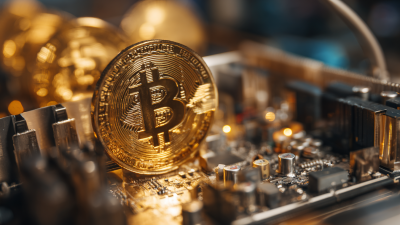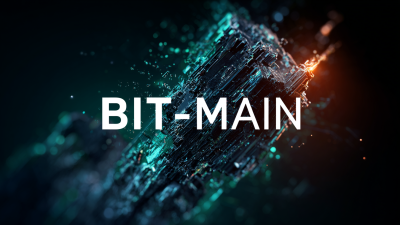Leave Your Message
The world of cryptocurrency is undergoing a transformative revolution, with Bit Coin miners playing a crucial role in this dynamic landscape. As of 2023, the global Bitcoin mining industry has exceeded a staggering market value of $19 billion, as reported by recent industry analysis. This remarkable growth is fueled by the increasing demand for decentralized digital currencies and the technological advancements in mining hardware and software. In this context, understanding the intricacies of Bitcoin mining becomes essential for newcomers seeking to navigate this complex but rewarding environment. With an estimated 200,000 active miners contributing to the network's security and transaction validation, each Bit Coin miner not only impacts the cryptocurrency market but also represents a significant investment opportunity. This guide aims to demystify the process of crypto mining, offering insights into best practices, tools, and strategies that can empower beginners on their journey into the world of Bitcoin mining.

Bitcoin mining plays a crucial role in the broader crypto ecosystem, acting as the backbone of the Bitcoin network. At its core, mining involves solving complex mathematical problems to validate transactions and add them to the blockchain. This process not only secures the network but also prevents double-spending, ensuring that Bitcoin remains a decentralized and trustworthy currency. Miners are rewarded with freshly minted bitcoins, providing an incentive for their investment in computational power and resources.
Understanding the basics of Bitcoin mining is essential for anyone interested in the cryptocurrency landscape. Each miner competes to solve a puzzle, and the first to succeed gets to add a new block to the blockchain. This competition among miners contributes to the network's security, as a significant amount of computational power is required to alter any single block. Therefore, the mining process not only generates new bitcoins but also reinforces the integrity of the entire system, making it an indispensable factor in the success and sustainability of cryptocurrencies.
| Aspect | Description | Importance |
|---|---|---|
| Mining Process | Involves solving cryptographic challenges to validate transactions and add new blocks to the blockchain. | Secures the network and maintains integrity of the blockchain. |
| Mining Hardware | Specialized computers (ASIC miners) designed to perform the computations required for mining. | Enhanced efficiency can lead to higher chances of earning Bitcoin. |
| Mining Pools | Groups of miners that combine their computational power to increase the chances of mining a block. | More consistent payouts, spreading the reward across participants. |
| Electricity Costs | Mining consumes significant energy, affecting overall profitability. | High electricity costs can negate profits; efficiency is crucial. |
| Mining Difficulty | A measure of how hard it is to find a new block; increases with more miners. | Balances the rate of block creation, ensuring network security over time. |
| Rewards | Miners receive Bitcoin as rewards for solving blocks and transaction fees. | Incentivizes participation in network security and transaction validation. |
When diving into Bitcoin mining, understanding the essential hardware and software requirements is crucial for success. The primary hardware component needed is an Application-Specific Integrated Circuit (ASIC) miner, which is a specialized device designed solely for mining Bitcoin. According to a report by the Cambridge Centre for Alternative Finance, ASIC miners can perform computations at much higher speeds compared to traditional CPUs or GPUs, achieving hash rates exceeding 100 TH/s. This efficiency is vital as the Bitcoin network becomes increasingly competitive.
In addition to robust hardware, miners must also consider the software that operates these devices. Mining software needs to be compatible with ASIC machines and should integrate seamlessly with mining pools for better resource management. Popular options include CGMiner and BFGMiner, which provide flexibility and customization to miners. A 2022 study from BitInfoCharts indicates that mining pools control over 65% of the Bitcoin network hash rate, highlighting the importance of choosing the right software to connect with these pools efficiently. Without the right combination of hardware and software, miners may find it challenging to yield significant returns on their investment in this dynamic and rapidly evolving industry.
Setting up your own Bitcoin mining rig can seem daunting, but with the right guidance, it becomes an achievable task for beginners. First, you’ll need to choose the right hardware. According to a recent report from the Cambridge Centre for Alternative Finance, over 60% of Bitcoin mining occurs using specialized hardware known as ASICs (Application-Specific Integrated Circuits). These machines are far more efficient compared to traditional GPUs, offering significantly higher hash rates, which are crucial for mining success.
Once your hardware is ready, configuring your mining software is the next step. Many miners opt for software like CGMiner or BFGMiner due to their user-friendly interfaces and robust performance. Additionally, joining a mining pool can enhance your chances of earning Bitcoin. By sharing resources with other miners, you can combine your computing power and increase the likelihood of solving blocks. Industry statistics show that miners involved in pools receive relatively stable payouts compared to solo miners, who may wait longer for rewards. Following these steps will set you on the path to participating in the cryptocurrency revolution with your own mining rig.
Mining pools have emerged as a vital aspect of the Bitcoin mining landscape, allowing individual miners to collaborate and share resources for greater efficiency and rewards. By joining a pool, miners combine their computational power, which increases their chances of successfully solving complex mathematical problems and earning Bitcoin. This collective approach mitigates the unpredictable nature of mining, making it a more stable and appealing option for beginners.
In a mining pool, rewards are typically distributed proportionally based on the amount of work contributed by each member, which fosters a spirit of collaboration. New miners may find this particularly advantageous, as it lowers the barrier to entry and makes it possible to receive smaller, more consistent payouts rather than risking a large investment in solo mining that may yield little to no return.
As the crypto mining revolution continues to grow, understanding the dynamics of mining pools becomes an essential step for anyone looking to navigate the world of Bitcoin mining effectively.
Bitcoin mining presents a multitude of challenges for newcomers venturing into this dynamic landscape. One fundamental issue is the high energy costs associated with mining operations, which can deter potential miners due to the financial burden. Reports highlight that there are ongoing discussions about implementing legal solutions to regulate energy consumption, aiming for a more climate-friendly approach. This not only addresses environmental concerns but also encourages miners to adopt more sustainable practices that can enhance profitability in the long run.
Furthermore, the rapid technological advancements in crypto mining, particularly with next-gen data centers, open avenues for improved efficiency and reduced costs. These facilities are designed to not only maximize profitability but also prioritize sustainability. As institutional investments flood into the cryptocurrency space, the demand for innovative solutions becomes more pronounced. New miners must stay abreast of these trends, as they present both challenges and opportunities for profitability in an ever-evolving sector.
This bar chart represents the changes in Bitcoin mining difficulty from January to August 2023. As the mining difficulty increases over time, it highlights the challenges new miners face in an evolving crypto landscape.






